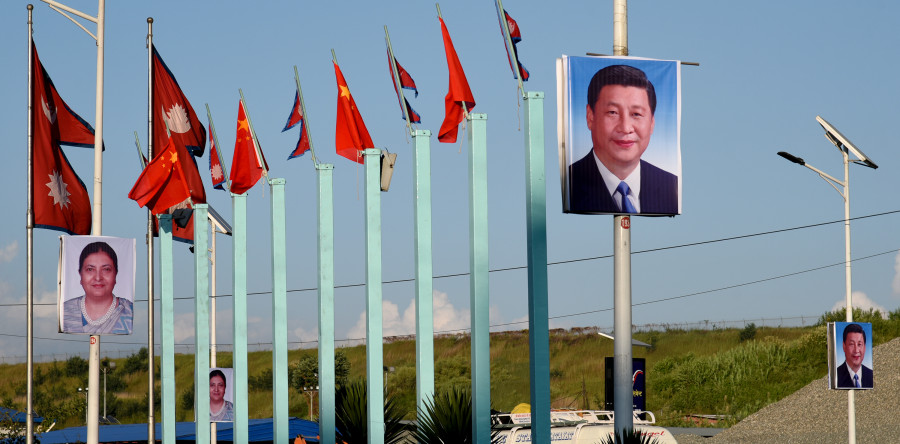Columns
Towards a shared future
President Xi’s visit to Nepal provides an opportunity to take the friendship between the two countries to new heights.
Gao Liang
Preparations to welcome Chinese President Xi Jinping’s visit to Nepal were in full swing over the past few days. This excitement is justified, though. Not only is this the first visit by a Chinese president in 23 years, since Jiang Zemin landed in Kathmandu in 1996, but this visit also provides the opportunity to redefine the relations between the two countries which would benefit the citizens of both the countries directly. China has great ambitions, but it's now time to strengthen its neighbour to grow together. Xi's visit has these unique and immense significances.
In this heavily interlinked world, cooperation is the key, and China knows that better. The culture of competition, yet collaboration is what China has been adopting since its opening to the outer world. The guiding principle of Xi Jinping's neighbouring diplomacy is to build a good neighbourhood harmonising, stabilising and enriching the neighbours. That is, to develop friendly and harmonious relations with neighbouring countries, jointly safeguard regional security, and achieve shared prosperity through mutually beneficial cooperation.
The core value of the Belt and Road Initiative (BRI) is consistent with that of the shared-future theory. The Chinese sincerely hope that neighbouring countries will take the ride of China's fast economic growth and share the opportunities.
China has the sincerity and ability to play a constructive role in Nepal's economic and social development where it wants to create a win-win situation for both countries. The ultimate goal of Nepal's participation in the Belt and Road Initiative is to cement its ties with China further. This includes narrowing the gap between Nepal and China, and the rest of the world. Like its cooperation with other countries, China can also obtain economic benefits from its links with Nepal. More importantly, the increasing interconnection in this process will bring the two countries closer together.
This will reinforce peace and stability not only for China and Nepal but also for the whole region. Thus, from a long-term perspective, enhancing connectivity between the two countries is the beginning to realising a shared future.
Nepal’s foreign policy has been adjusting in a directionless manner in the past few years, yet it is still fair enough to conclude that its core spirit is pursuing a more diversified policy, which can be summarised as dynamic balancing when it comes to political relations and diversification in maintaining economic ties.
By deepening cooperation with China through the Belt and Road Initiative, and being linked to the world's second-largest economy, Nepal is injecting new vitality into its domestic economy and opening broader prospects. Geographical location and historical factors had long kept the country isolated from the world. What’s more, a protracted period of political instability took a heavy toll on the country. But now that the country has embarked on a journey to stability and prosperity, the newfound zeal to open up integrate into the world, which has been proven to be an effective way to promote development in China, should also be a consensus among all walks of life in Nepal.
The much-anticipated President Xi’s visit to Nepal will definitely add new dynamics to the Sino-Nepalese relations. Since May 2017, China and Nepal signed the Memorandum of Understanding on BRI, the two countries have made remarkable progress in the areas of interconnection, investing, trading, and personnel exchanges. This is undoubtedly a good start. From hydro projects to building infrastructure, China has been making inroads into Nepal along with enjoying a cordial relationship with the political leadership. Now that the Belt and Road Initiative has entered its sixth year, its cooperating models and paths are getting more mature. Now, after two years of running-in and preparation, the cooperation between the two countries under the framework of BRI will undoubtedly expedite. The speed of implementing projects shall be accelerated, broader fields shall be involved and more agreements shall be reached upon.
The differences in the political system, cultural and social environment between China and Nepal are facts, but this should not be an obstacle in deepening cooperation, for the people of both countries have the same yearning for a better life and share the same determination. In 1996, when Chinese President Jiang Zemin was visiting Nepal, the country was heading into a prolonged political turmoil. Today, Nepal’s political order has been rebuilt, and people’s demands for embarking on the path of prosperity are stronger than ever. In the past 23 years, China has also undergone more profound reforms and changes. The two countries are sharing better connections, closer ties, and broader prospects. At such a moment, we have good reasons to put higher expectations to the forthcoming visit and the future of Nepal-China relations.
***
What do you think?
Dear reader, we’d like to hear from you. We regularly publish letters to the editor on contemporary issues or direct responses to something the Post has recently published. Please send your letters to [email protected] with "Letter to the Editor" in the subject line. Please include your name, location, and a contact address so one of our editors can reach out to you.




 6.73°C Kathmandu
6.73°C Kathmandu















